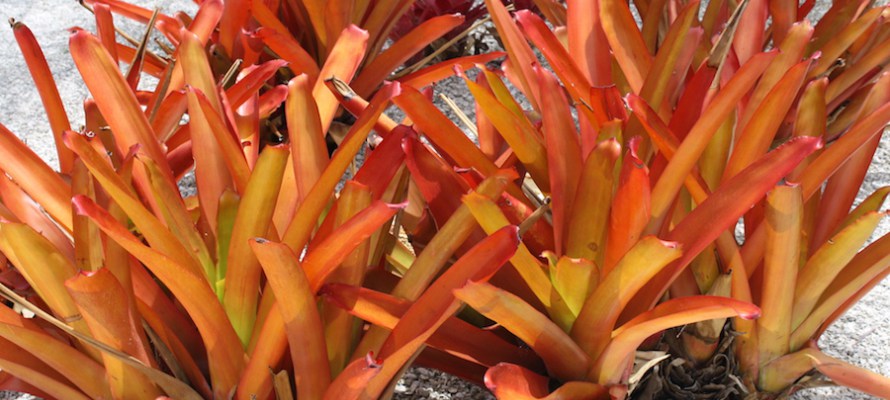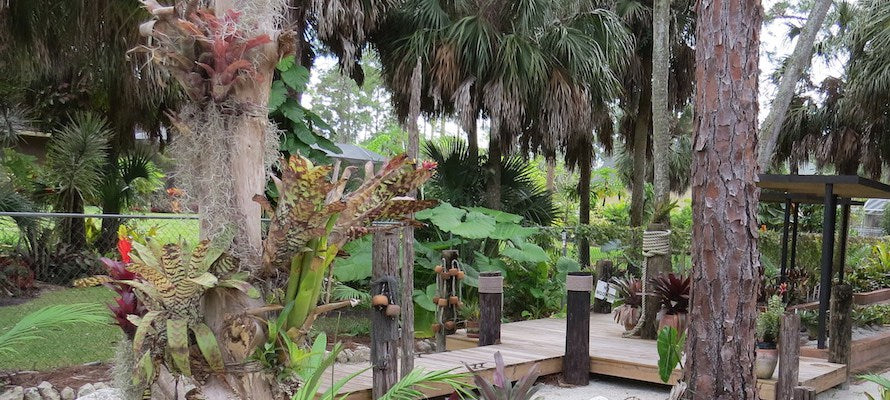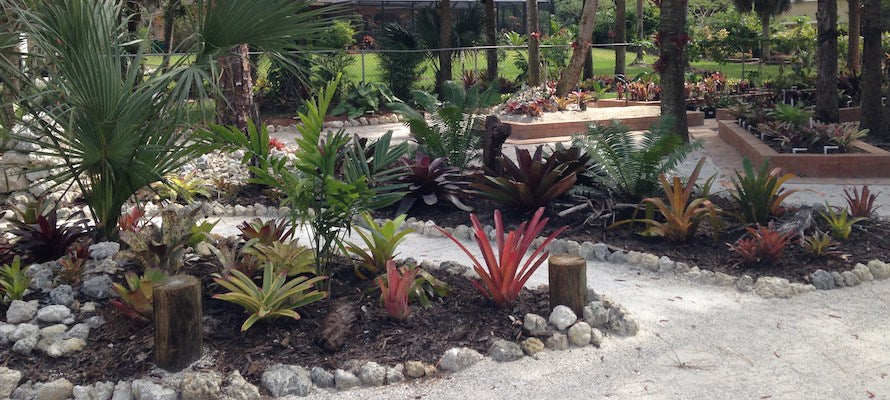Your Cart is Empty
Get Free Shipping on all orders $120 or more.

Do you have an unprotected area of your yard and are looking to fill it in with some full sun bromeliads?
Even though your bromeliad may be full sun tolerant or even love full sun, it may not be ready to be placed in it just yet.
A lot of plants will become stressed when disturbed and re-located, and if put in full sun right away, it may not have the energy to protect itself and end up getting burnt or even die.
The last thing you want is to lose your new addition—so how do you transition your bromeliad while ensuring its health?
You must acclimate your bromeliads to full sun conditions.
The key to acclimating any bromeliad to a full sun location is patience.
Depending on where you live you may get different results, but you never want to rush the process or you can risk the life of your plant.
Here are some general rules to follow to ensure success.
Before we get into the steps, it’s important to note where you live for a couple of factors.
The first is the intensity of the sun and heat in your location.
Depending on your latitude, plants will either acclimate quickly, or need more time. For instance, here in South Florida, we are much closer to the equator so the sun is a bit more intense than even Southern California or Texas.
The closer to the equator you get, the closer the sun is to the earth, and the stronger and more intense the sun is, which means the longer it may take to acclimate a plant to full sun conditions.
The second factor is humidity.
Bromeliads take in water and breath through their leaves. The water acts as sort of a ‘sunscreen’ and protects the plant from getting burned.
Again, this is why South Florida allows some full sun bromeliads to thrive, even though the sun is more intense, and why bromeliads in Arizona or Texas deserts will die quickly if not watered regularly.
So make sure you understand your location’s conditions and whether the sun may be too intense or there is not enough moisture in the air to keep your plants safe.
Next, as stated earlier, you want to make sure that you are using a full sun tolerant bromeliad.
We have a nice list of all of the full sun bromeliads that we currently have available if you are looking, and you can find more in our Bromeliad Care Guide.
When you take a cutting or have pruned the roots of a recently acquired bromeliad, the plant will spend a good amount of energy growing new roots. This takes energy away from maintaining a healthy leaf structure and can create stress.
Always allow your bromeliad to grow a well-established root system before moving it or planting it into the ground.
Before a bromeliad has fully adapted to the increased sun exposure, it doesn’t know how much water it needs to retain, so the sun will begin to dry out the leaves.
However, bromeliads with well-established root systems are able to use those roots to replace lost moisture and keep the plant from fully drying out.
We don’t want to stress the plant out further by forcing it to expend too much energy trying to adapt to new lighting conditions.
Placing plants in filtered light while growing new roots will give them the protection they need to thrive.
Once roots are established, it is always a good idea to move your plant into a high exposure environment gradually, and when the sun’s rays are less intense.
If you live in an area that doesn’t get below freezing in the winter, then the beginning of winter is the best time of year as the days are shorter and the sun is further from earth.
If that is not possible, then the beginning of spring when any threat of frost has past is the next best time.
Now the process for acclimating your plant is pretty straightforward.
Increase the sunlight about 20% per week until the plant can be in its full sun location without any browning of its leaves.
The important part here is increasing the filtering of light, not just the exposure.
Don’t just place the bromeliad near a wall where it will go from full sun to full shade, just increasing the length of time in the sun.
A better way of acclimating it is to place it under a tree or other covering where it gets filtered light, and gradually move it further out into the sun so it gets less and less filtering.
Avoid overwatering during this process, but keep your bromeliad hydrated. Keep the cup filled and lightly spray the leaves without over-saturating the soil and roots.
Look for any browning or bleaching in the leaves. If at any time you start to see this happening, move the plant back into a little more shade and make sure it is hydrated.
Keep it clear of any rock piles or concrete that may provide extra heat.
Once your plant becomes acclimated to its new location, make sure not to disturb the new roots too much.
If you are leaving it in its pot then you are all set, but if you are planting it in the ground, either keep it in its current pot under the soil, or try to transfer it from the pot as carefully as possible.
Now that your bromeliad is acclimated and in its new location, you can water and fertilize it like normal. Don’t worry too much if it lost its color during the process. With more sun and new roots, it will begin to grow more leaves and start to develop its color.
Do you have any other tips or tricks? We would love to hear them in the comments.
The post How to Acclimate Your Bromeliad to Full Sun appeared first on Bromeliad Paradise.

When a bromeliad is ordered on-line, it will either be taken as an offset from a mother plant, or it will be taken from a pot. Either way, it is possible that it has already started to grow roots.

Bromeliads are a type of plant called epiphytes, which means that they draw moisture from the air and don’t need to be in soil to survive. While their roots can draw water and nutrients, they typically serve as a plant’s ‘anchor’, attaching and holding it place.

Although mosquitoes are not a pest that can harm your bromeliads, they can become very annoying to everyone around them. Mosquitoes are currently a topic of conversation as common sense and the facts often give way to rumor and sensationalism.